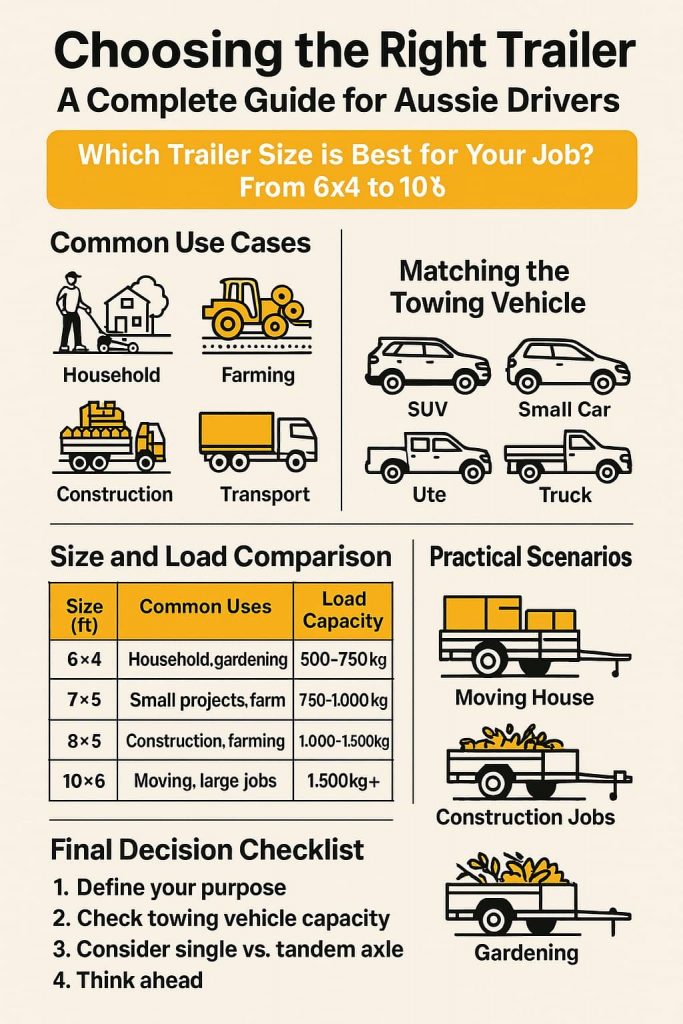Which Trailer Size is Best for Your Job? From 6×4 to 10×6
When it comes to choosing a trailer in Australia, there’s no one-size-fits-all answer. Whether you’re a weekend gardener, a farmer moving supplies, or a builder hauling equipment, the trailer you select will directly affect your efficiency and safety on the road. This guide will help Aussie drivers understand which trailer suits their needs best, from compact 6×4 trailers to heavy-duty 10×6 options.
1. Common Use Cases: Household, Farming, Construction, and Transport
- Household Use
For everyday tasks such as moving furniture, cleaning up garden waste, or weekend DIY projects, a 6×4 single axle trailer is the most popular choice. It’s lightweight, easy to tow, and affordable, making it perfect for families and small jobs. - Farming Use
Farmers often require larger trailers to move tools, feed, or livestock equipment. An 8×5 or 10×6 trailer provides the extra capacity needed for bulky or heavy loads. Tandem axle trailers are recommended in this category, as they provide better stability and durability for rough farm conditions. - Construction Industry
Builders and contractors often need trailers that can carry heavy equipment, sand, timber, or concrete tools. Tandem axle 8×5 trailers are a staple on Australian worksites due to their ability to handle high loads and long hours of work without compromising safety. - Transport and Logistics
Professional transporters usually rely on large-capacity trailers or even custom-built models. The focus here is not only load size but also compliance with road regulations and durability for long-distance hauling.
2. Matching the Trailer with Your Towing Vehicle
A trailer is only as good as the vehicle that tows it. Choosing the right combination ensures safety and efficiency:
- Small Cars: Suitable for light loads and 6×4 trailers.
- SUVs: Offer more towing capacity, making 7×5 or 8×5 trailers a comfortable fit.
- Utes (Pick-up trucks): The workhorse of Australia, capable of towing 8×5 or 10×6 trailers with ease.
- Trucks: Best for professional hauling and oversized trailers.
Always check your vehicle’s towing capacity before making a purchase, as exceeding limits can result in fines and increased accident risk.
3. Trailer Size and Load Comparison Table
| Size (ft) | Common Uses | Load Capacity Range | Recommended Vehicles |
|---|---|---|---|
| 6×4 | Household, gardening | 500–750kg | Small car / SUV |
| 7×5 | Small projects, farm | 750–1,000kg | SUV / Ute |
| 8×5 | Construction, farming | 1,000–1,500kg | Ute / SUV |
| 10×6 | Moving, large jobs | 1,500kg+ | Ute / Truck |
4. Practical Scenarios: Moving House vs. Construction vs. Gardening
- Moving House
When moving furniture, appliances, and personal belongings, a 10×6 trailer is ideal. It saves multiple trips and provides enough room for bulky items. - Construction Jobs
A builder transporting timber, tools, or rubble should opt for an 8×5 tandem axle trailer. The dual axles distribute weight evenly, offering stability and safety. - Gardening and Landscaping
For weekend garden cleanups or small landscaping jobs, a 6×4 single axle trailer is sufficient. It’s easy to maneuver, even in suburban driveways.
5. Final Decision Checklist
- Define your purpose: Household, farm, or commercial?
- Check towing vehicle capacity: Don’t exceed manufacturer recommendations.
- Consider single vs. tandem axle: Tandem is safer for heavy-duty, single axle is lighter and cheaper.
- Think ahead: If your needs may grow, invest in a larger trailer now to save future costs.
6. Frequently Asked Questions (FAQs)
Q1: What is the most popular trailer size in Australia?
A: The 6×4 single axle trailer is the most common choice for households, thanks to its affordability and versatility.
Q2: Is a tandem axle trailer worth the extra cost?
A: Yes, if you plan to carry heavy loads frequently. Tandem axles provide better balance, braking, and stability on rough roads.
Q3: Can my SUV tow an 8×5 trailer?
A: Most modern SUVs can tow up to 2,000kg, so an 8×5 trailer is usually safe. Always confirm your vehicle’s manual for towing limits.
Q4: Do I need brakes on my trailer?
A: In Australia, trailers exceeding 750kg ATM (Aggregate Trailer Mass) must be fitted with brakes by law.
Q5: Should I buy new or used?
A: New trailers offer warranties and better build quality, while used trailers are cheaper but may require maintenance.
Conclusion
Choosing the right trailer comes down to understanding your use case, matching with the right towing vehicle, and planning for the future. For households, a 6×4 is perfect. For farms and construction, an 8×5 tandem axle is the most reliable option. And for big moves, a 10×6 provides all the space you’ll need.
A well-chosen trailer isn’t just a tool—it’s an investment in efficiency, safety, and long-term reliability.

